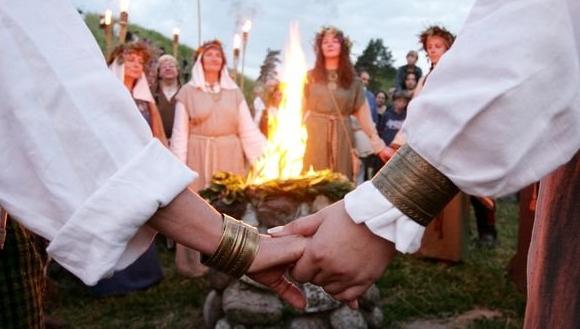The festival of the Myrrh-Bearers: history, traditions and script of the Orthodox holiday
It so happened that many ChristianOrthodox holidays were imposed on the more ancient pagan. It was done so that the people would get used to the new religion better and faster, adapt to the changed requirements and conditions of life. An example of such celebrations is the history of myrrh-bearers.
Date of celebration

Two Marys
Before us came the names of those in whose person the OrthodoxThe church honors the female half of humanity. These are two Marys - one known to all Magdalene, a former sinner repenting in her debauchery and accepting the covenants of Christ as the main and necessary for life. The second is Kleopova. According to various sources, she was either the sister of the mother of Christ, or the wife of the brother of St. Joseph the Betrothed - the husband of the mother of Jesus. The third biblical texts speak of her as the parent of the relatives of the Son of God-James, Josiah, Simon, and Judas. There is also a celebration of the Myrrh-bearers in memory of John, a faithful disciple of Christ. She went with other listeners of Him in Galilee and secretly buried the head of John the Baptist, when Herod destroyed it.

Mother of apostles and sisters of Lazarus
The high honor of church memory deserved andSalome. She is the mother of the disciples and apostles of Jesus, James and John. She was the first after Magdalene Christ appeared at his resurrection. In the various Gospels, the sisters of Martha and Mary come from Bethany, and their Savior honored with his presence and preaching. But they believed in Him after the resurrection of Christ by their brother Lazarus. And, of course, Susanna, spoken of by the Evangelist Luke, she served the Son of God "from her possessions." Thanks to these personalities, the pious and righteous Christian women have long since been congratulated on the holiday of the Myrrh-bearers.
About event

Spiritual and moral ties
Wife-bearers were revered in Russia especially.This is due to the element of piety in Russian culture and spirituality. Morality and morality, strict standards and requirements of Orthodoxy entered the flesh and blood of the people, especially the female part of it. Simple peasant women, pillar noblewomen, representatives of merchant class and philistine class tried to lead a righteous and honest life, in fear of God. Good deeds, donations to the needy, the distribution of charity to the poor and charitable deeds for the afflicted - all this was done by them with a special spiritual uplift and a desire to please the Lord. What is still characteristic of Russian Orthodoxy is the extremely chaste attitude to the sacrament of marriage. Fidelity to this word, the oath before the altar (that is, the covenants that Christ bequeathed) in the old days was a distinctive feature of a Russian woman. These ideals live in the people and now. Myrrh-bearers were distinguished by meekness, humility, patience, forgiveness. That's why they became a model for imitation. And the Russian land gave Christianity many saints and righteous, blessed and martyrs who, for the glory of Christ, did good. Mother Matrona, Xenia of Petersburg, Fevronia of Murom, Abbess Catherine and many others are revered among the people as intercessors, helpers, comforters, healers, true followers of the work of Christ.
Orthodox International Women's Day

Ancient Slavonic roots

Women's festivals

Other names of the holiday and its connection with Christianity
This day the people had many names.The main definition in them pointed specifically to the feminine principle. He was so cliched: "The Babe's Eggs", "The Woman's Bratchina", "The Woman's Week", "Kumitnym" or "The Curling" Sunday (from the "curling" of the birches - the interlacing of its branches in the form of an arch and the braid braid). What's interesting: almost in no Russian province there was a single regulation of the celebrations. In Pskov or Smolensk, Kostroma and Nizhny Novgorod, as well as in others, "Indian Sunday", or the holiday of myrrh-bearers, was marked in its own way. The scenario is different. The only thing that united them - on the eve of the day women went to their houses, collected bread, pastries, eggs, other products for a common feast. On a festive day, unmarried girls, their elder relatives, first went to church to defend the mass. After they ordered a general prayer service for the entire female part of the village. We paid for it not with money, but with eggs, which also included the ritual of the Myrrh-Bearing Week. And by the evening there was actually a celebration: with dances and songs and other attributes of the holiday. And then the feast followed. In the regions where flax was grown, for an abundant harvest, fried eggs were often eaten under a special plot.

Funeral motives
Among the days of Myrrh-Bearing Weektime was allocated for the commemoration of the dead. For these purposes, in every parish there was a common sorokoust - secular, for the deceased members of the church. On Parent Saturday, during the Myrrh-bearing Sunday, cemeteries were visited in many towns and crayons were left on the graves. In this tradition, too, echoes of echoes of pagan cults, in particular, the cult of ancestors. Played its role in the emergence of the holiday and the deification of nature, the change of seasons, as well as the onset of agricultural pores.
"Myrrh-Bearing" Days Today
Orthodox women's holiday celebrated todayin all the Christian parishes of Russia and beyond. In Sunday schools, with churches, the teachers prepare a concert for their mothers, grandmothers and sisters with the children. In songs, poems, play scenes on scenes from the Holy Scripture, they glorify not only the biblical heroines, saints, but also all women - successors of the human race, the embodiment of peace, good, love. If there are workshops at Sunday schools, mentors and students prepare small gifts for the guests. These are, as a rule, frames and shelves for icons, wooden painted or with burnt eggs patterns, bags for prosphorons and other beautiful and useful items, as well as thematic drawings, applications. Organized with a soul, such holidays leave a deep mark on the heart and have a huge educational and moral significance.
Temple celebrations
In all Orthodox churches, churches and cathedrals inthese days are solemn divine services. Everywhere pilgrims come to places of faith to feel their community with the whole Church of Christ. Lay people attend services no less jealously than Orthodox believers. Within the walls of God's houses, in pious examples of clerics, in the wisdom of the Holy Scripture, they seek and find support that helps us survive in our hard times and give hope for the future. After the Divine Liturgy, the pastors turn to the parishioners with the word "Person" - a heartfelt sermon, in which they congratulate all women on a bright, joyful holiday.

The Church respectfully and venerately refers not toonly to the feat of biblical wives. The holy fathers pay special attention in their Word to the glorified and little-known, modest toilers of the Faith. Everyone who works on the spiritual field, the Christian field, performing daily, sometimes unnoticed feat to the glory of God, is addressed with words of gratitude, wishes of the Lord's grace, health and peace - in souls, in families, between people. In their sermons, the pastors emphasize that without women's participation, without the support of women, and their painstaking work for the benefit of the Church, Christianity would not have become so widespread. In Russia, for example, in the epoch of atheism, it was women who remained the bulwark of faith and unbending courage. Therefore, although they are called the weaker sex, their mission in Orthodoxy is considerable. This is something that parishioners should always remember and remain the personification of spiritual purity, chastity, the bearers of eternal orthodox moral values. Women must fight for peace, and the example of the Myrrh-bearing women inspires them on this thorny path.











